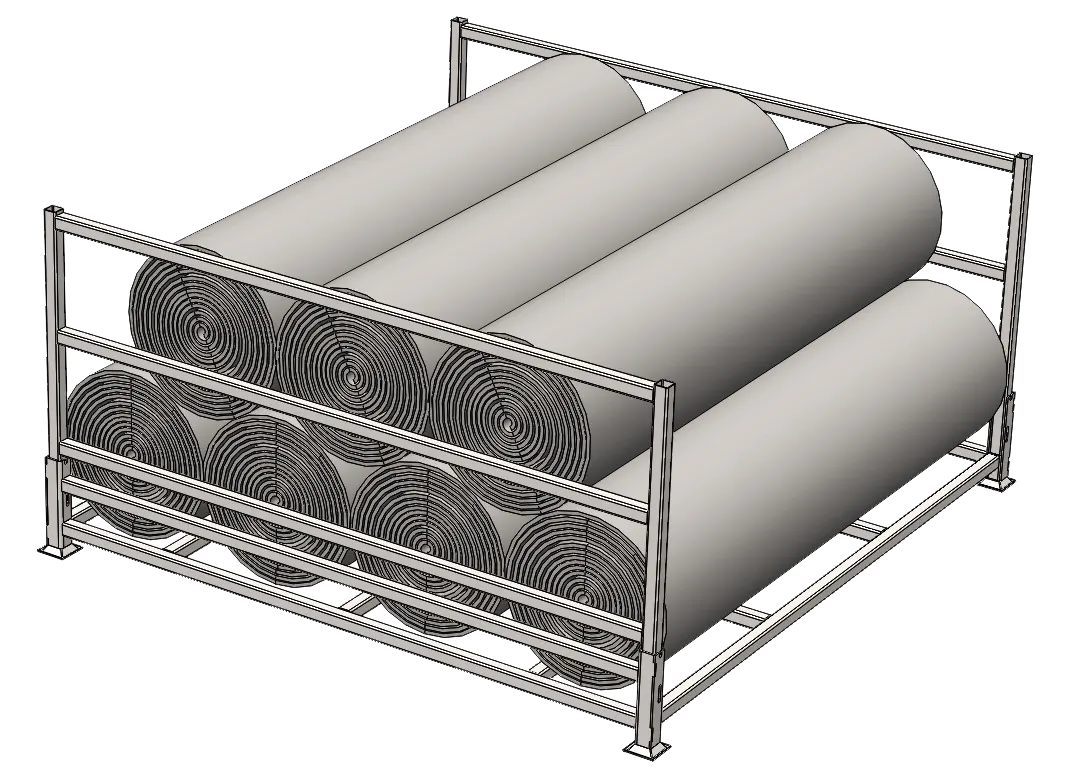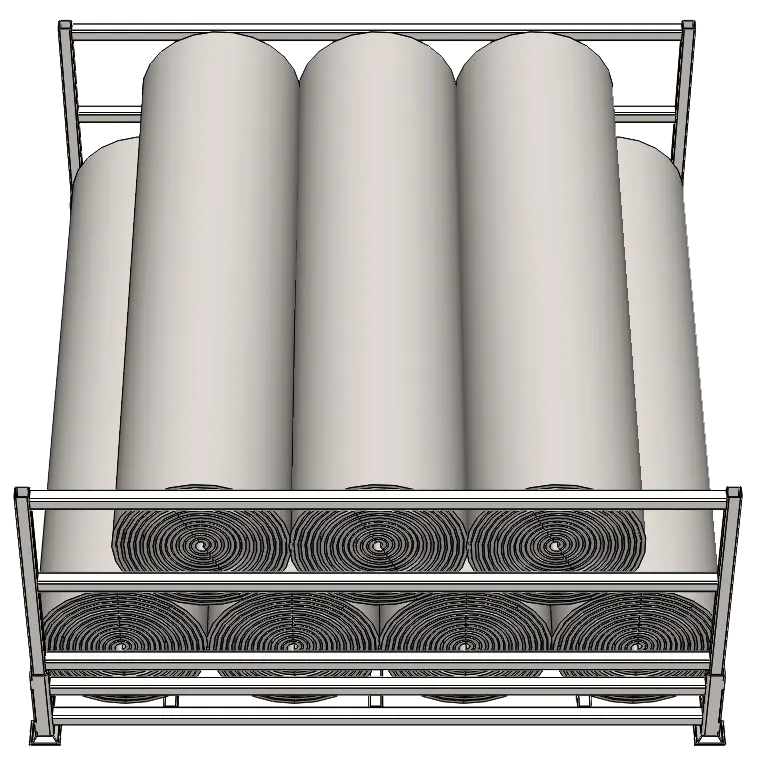Explore innovative designs, practical applications, and the numerous benefits of utilizing a wine barrel rack for your facility.
Read MoreCarpet Roll Racking Systems: Roll with Ease
What are carpet roll racking systems?
Carpet roll racking systems are storage systems specifically designed to hold and organize rolls of carpets. They consist of adjustable shelves or racks that can hold multiple rolls of varying sizes and lengths. These systems are often used in carpet warehouses, retail stores, and manufacturing facilities.
The importance of carpet roll racking systems for carpet storage cannot be overstated. Carpets are heavy and bulky, making them challenging to store and organize efficiently. Without a proper storage solution, carpets can take up valuable floor space, become damaged or tangled, and create hazards in the workplace.

Understanding the need for efficient carpet storage
The challenges of carpet storage
The storage of carpets presents various challenges for businesses. Carpets are large and unwieldy, often requiring significant space for storage. Additionally, carpets are prone to damage, such as creasing or tearing, if not stored properly. This can result in significant financial losses for carpet businesses.
Benefits of using carpet roll racking systems
Using these systems can help overcome the challenges of carpet storage. These systems provide several key benefits, including:
-
Maximizing storage capacity: Carpet roll racking systems maximize vertical space, allowing businesses to store more carpets in a compact area. Ultimately, this helps optimize storage capacity and frees up valuable floor space.
-
Efficient inventory management: With these racking systems, carpets can be organized and labeled, making it easier to locate and retrieve specific items. As a result, this improves inventory management and streamlines operations.
-
Reduced carpet damage: Properly storing carpets in roll racking systems minimizes the risk of damage, such as creasing, tearing, or tangling. This helps maintain the quality and value of the carpets.
Types of carpet roll racking systems
There are several types of racking systems available to accommodate different storage needs. Here are three common types:
-
Static carpet roll racking systems: These systems consist of fixed racks that provide basic storage for carpets. They are the most common and cost-effective option, suitable for businesses with limited space and a relatively small carpet inventory.
-
Mobile carpet roll racking systems: Mobile racking systems consist of racks that can be moved laterally on rails. Essentially, this will eliminate the need for aisles between racks which will allow for compact storage. Mobile systems are ideal for businesses with larger inventories and sufficient space.
-
Automated carpet roll racking systems: Automated systems use robotics and sensors to handle the loading, unloading, and storage of carpets. They offer high-density storage and increased efficiency, making them suitable for large-scale carpet storage operations.
Each type of carpet roll racking system has its advantages and considerations, so businesses should carefully assess their requirements before choosing the most suitable option.
How do carpet roll racking systems work?
Carpet roll racking systems consist of several components that work together to facilitate efficient storage and retrieval of carpets. The key components include:
1. Racking frames: These frames provide the structural support for the system, holding the shelves and carpets in place.
2. Adjustable shelves: The shelves can be customized to accommodate carpets of various sizes and lengths. Also, they can be moved or reconfigured as needed to maximize storage space.
3. Loading and unloading mechanisms: These racking systems may have manual or automated loading and unloading mechanisms. Manual systems require manual labor to load and unload carpets, while automated systems use robotics or conveyor systems to perform these tasks.
4. Safety features: Safety is a crucial consideration for carpet roll racking systems. Systems may be equipped with safety devices such as sensors, locks, and safety barriers to prevent accidents and injuries.
Carpet roll racking systems operate on the principle of vertical storage, maximizing space utilization. Carpets are loaded onto the shelves or racks, usually using a forklift or other lifting equipment. The adjustable shelves allow for efficient organization based on size, type, or color, enabling businesses to categorize their carpets for easy retrieval.
Achieving maximum space utilization is crucial for these racking systems. Adjustable shelves make it easy for businesses to configure the storage system based on their specific needs. By optimizing the arrangement of carpets, businesses can make the most of their available storage space.
Factors to consider when choosing carpet roll racking systems
When selecting a carpet roll racking system, businesses need to consider several factors to ensure they choose the most suitable option for their needs. Some essential factors to consider include:
-
Carpet weight capacity: Different systems have different weight capacities, so it’s crucial to choose a system that can safely hold the weight of your carpets.
-
Size and dimensions of the racking system: Consider the available space you have for the system and choose one that fits within those dimensions while maximizing your storage capacity.
-
Accessibility and ease of retrieval: Determine how easy it will be to access and retrieve carpets from the system. Consider factors such as aisle widths, loading height, and any special requirements for maneuvering carpets.
-
Safety features and certifications: Ensure that the system meets all necessary safety standards and certifications to minimize the risk of accidents and injuries.
By carefully considering these factors, businesses can choose a racking system that meets their specific storage needs, enhances efficiency, and ensures the safety of their employees.

Best practices for organizing carpets in roll racking systems
Organizing carpets effectively within a roll racking system is essential for efficient operations. Here are some best practices to consider:
-
Categorizing carpets by size, type, or color: Creating categories based on different criteria makes it easy to locate specific carpets quickly. In addition, this organization method can help with inventory management and facilitate efficient retrieval.
-
Utilizing labeling systems for easy identification: Labeling each shelf or section helps employees quickly locate and retrieve carpets. As a result, this clear and concise labeling method will aid in maintaining accurate inventory records.
-
Regular maintenance and inspections to ensure system integrity: Performing regular maintenance and inspections of the roll racking system helps identify and address any issues promptly. For that reason, this will ensure the system’s integrity and prevent potential hazards or damage to the stored carpets.
By implementing these best practices, businesses can optimize their carpet roll racking systems and ensure smooth operations in their carpet storage facilities.
Benefits of using carpet roll racking systems for carpet businesses
Implementing these racking systems within a carpet business offers numerous benefits that contribute to improved efficiency and cost savings. Some key benefits include:
-
Maximizing storage capacity and floor space utilization: Carpet roll racking systems allow businesses to store more carpets in a compact area, freeing up valuable floor space for other operations.
-
Efficient inventory management and retrieval: With organized and easily accessible carpets, inventory management becomes more efficient. Therefore, employees can quickly locate and retrieve desired carpets, reducing downtime and improving customer service.
-
Cost savings and reduced damage to carpets: Properly storing carpets in roll racking systems minimizes the risk of damage, reducing the need for repairs or replacements. Ultimately, this translates into cost savings for carpet businesses.
By utilizing carpet roll racking systems, carpet businesses can enhance their operations, improve customer satisfaction, and achieve cost savings in the long run.
Implementing carpet roll racking systems: Step-by-step guide
Implementing a carpet roll racking system involves several steps to ensure a smooth transition. Here is a step-by-step guide to help businesses with the implementation process:
-
Assessing storage needs and available space: Before selecting a system, evaluate your storage requirements and the amount of available space. Consider factors such as the carpet inventory size and future growth projections.
-
Selecting the appropriate type of system: Choose a carpet roll racking system that matches your specific requirements, taking into consideration factors such as available space, carpet weight, and ease of retrieval.
-
Installation and configuration: Once you have chosen a system, work with the manufacturer or supplier to install and configure the system correctly within your facility. Make sure to follow all safety guidelines during installation.
-
Training employees on system operation and safety guidelines: Provide comprehensive training to your employees on how to operate the carpet roll racking system safely. Emphasize the importance of following safety protocols and guidelines to prevent accidents or damage to the system.
Following these steps will ensure a smooth implementation and integration of the carpet roll racking system into your business operations.

Choosing the right carpet roll racking system for your business
Selecting the right racking system is crucial for optimizing storage efficiency and meeting the unique needs of your business. Here are some considerations to help you make an informed decision:
-
Considering budget constraints and specific requirements: Assess your budget limitations and the specific requirements of your carpet storage facility. Essentially, this will help you narrow down the available options and choose a system that aligns with your financial and operational needs.
-
Comparing features and capabilities of different systems: Take the time to research and compare the features and capabilities of different carpet roll racking systems. Consider factors such as weight capacity, adaptability, ease of use, and maintenance requirements.
By taking into account these considerations, you can ensure that the carpet roll racking system you choose is the right fit for your business, both functionally and financially.
Conclusion
Carpet roll racking systems offer an efficient and practical solution for storing and organizing carpets in the carpet industry. By utilizing these specialized storage systems, businesses can maximize storage capacity, improve inventory management, and reduce damage to their carpets. When choosing a carpet roll racking system, it is important to consider factors such as weight capacity, size and dimensions, accessibility, and safety features.
Implementing a system involves assessing storage needs, selecting the appropriate type, installation and configuration, and training employees on system operation and safety guidelines. By following maintenance and safety considerations, businesses can ensure the longevity and safe operation of their carpet roll racking systems.

Customize Your Own & Get a FREE Estimate!
Simply e-mail us at sales@plexformps.com with all your information
OR call us today & speak to one of our packaging professionals









